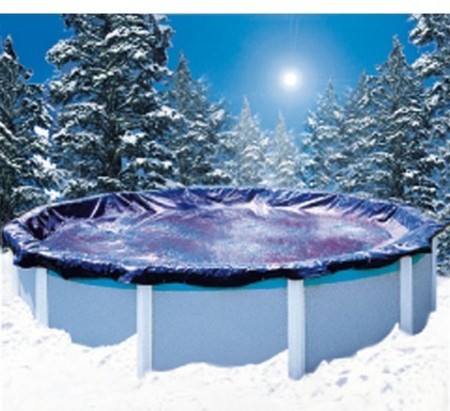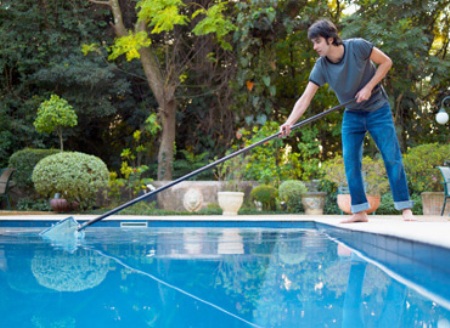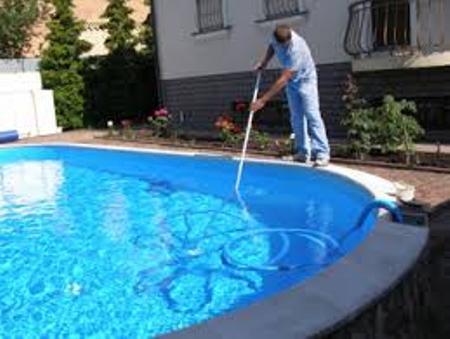To ensure the safety of the pool during the winter cold, it will be necessary to perform a number of procedures for the conservation of the object. The works will be aimed at eliminating the factors that can cause significant harm to an artificial reservoir. First of all, it is freezing water and soil. The outdoor pool in winter should be filled with water - expanding, the freezing soil will press the walls of the empty pool, with the onset of spring there will be a threat of squeezing the bowl onto the surface with melt water. The second task is to keep the water in the pool as clean as possible. To cope with this task will help special chemical compounds that will inhibit the growth of algae.
Content
Outdoor pool in winter - pool conservation activities
Conservation of the pool for the winter is not a difficult task, although it will require some time. You can do all the work yourself. Although special training is not needed for this, but you will still need to carefully study the instructions for swimming pool maintenance - some pool models require additional work.
If there are doubts about the correctness of the actions - it is better to turn to specialists, rather high cost of swimming pools obliges to treat them with knowledge of the matter. Start work should be before frost, the best - immediately after the end of the swimming season, approximately - at the end of September. To conserve the basin, you will need:
- covering material,
- chemical preparations for disinfection,
- pressure compensators created by ice,
- if skimmers are used, then prepare the plugs for them.
Preservation can be exposed to a pond full of water of proper purity, with a certain chemical composition. If the water in the pool is contaminated, then it must be completely drained, using the recommended means of cleaning the pools to put in order its walls and the bottom, rinse with clean water. The chemical composition of the newly filled water should be correct. This will help avoid staining the walls and the appearance of plaque on them.
If the pool is equipped with lighting - it will need to be removed after you let the water out of the pond. Electrical wires must be secured over the sides of the pool, must be insulated. The nozzles will need to be fitted with protective caps, they will not be required if the water level is below the line of their placement by 10 cm. Before installing the plugs, it is necessary to pump air into the filtration systems, the plugs should be installed without shutting down the compressor. It will also be necessary to remove:
- filters,
- pump,
- all attachments.
The water heating system must be disconnected, all hoses and pipes leading to the engineering systems of the pool must be sealed. For the preservation of water in the pool, shock chlorination is usually used, the chlorine after it should be equal to 3. To reduce the pressure exerted by freezing water on the walls of the pool, water is placed in the expansion joints. These can be special floats purchased in the store, but you can use improvised tools, such as:
- foam blocks,
- cans and bottles of plastic,
- air mattress.

Next, the pool is covered with protective material. The pool cover should be strong enough - it will have to withstand the loads created by the snow cover. A pool that is preserved in this way should normally withstand winter cold.
On the preparation of the pool for winter, look at the video:
Conservation of the basin
It is possible to start the re-opening of the basin in April-May, when the average night temperature will hold at + 10-12 ° C. By this time, all ice must also go off. To achieve the melting of ice by artificial means is dangerous - the walls of the basin can be hopelessly deformed.
garbage collection
First of all, you need to remove the veil, if you did not use it, then first remove from the water accumulated over the winter large debris: twigs, leaves, etc. To simplify the work, you should use the nets to remove debris from the bottom and from the surface of the water.

If the pool was covered with a film, then remove it carefully so that the garbage does not get into the water. At this stage, we also remove ice compensators from the pool.
pool cleaning
The next stage will require chemistry for swimming pools, to buy quality products for cleaning the surface of walls and floor today is easy, as well as reagents for disinfection and purification of water in the pool. The bowl is cleaned with hard plastic brushes, the cleaning agents are selected in accordance with the material from which the artificial pond is made, for example: it is not recommended to use the same means for tile as for PVC film - the pool cover can be damaged.
Since effective cleansers are quite aggressive preparations, safety standards must be observed when performing work with them. Work should be in protective gloves and rubber boots. Do not allow chemicals to leak into the environment. Another important point is the removal of all traces of deposits from the surface of metal parts. After cleaning all surfaces, the pool is carefully rinsed with running water. The remaining water must be removed manually.
pool repair
Next, a thorough examination of the walls and the bottom is made for damage. If defects are found in the coating - we eliminate them by ourselves, if the damage is complex - we turn to the specialists for help. Timely repairs carried out without problematic operation of the pool throughout the summer season.
connection of equipment
Then you can do the assembly, installation and connection of equipment that was filmed for the winter. During the work, do not forget that all connections and seals need to be carefully checked. If there is a need - pass the place of all joints with a sealant.
It's time to remove all the plugs installed in the fall, return to their original place and connect the floodlights of the lighting, injectors. After this, a repeated blowdown of the pipes is required. Also check the sand in the filters and, if necessary, replace it with fresh. Having made sure that all the preparatory work is done qualitatively, you can fill the pool with water.
we check and correct the chemical composition of water
After reading the instructions for starting the filter units, we proceed to start it. Simultaneously, we do a water analysis, measure the pH level, bring it to normal, perform a shock treatment of water with chlorine. At the end of the time, we treat the water with reagents intended for permanent disinfection and algaecides.
Select algaecides should be given that the types of water treatment can be different:
- ozone,
- chlorine,
- oxygen.
For each type, an algicide of another type is intended, if the preparations are chosen incorrectly, they will not normally perform their functions. To remove organic residues, the flocculant formed during the chlorination process adds flocculent to water, it forms large flakes that will be removed from the water during filtration.
Watch a video about swimming pool chemistry:
starting the pump
It should be remembered: before starting the pump, its pre-filter must be filled with water. For all pumps this option is recommended, but for non-self-priming pumps it is necessary. Operation of the pump without water is not allowed. Running the filter unit should run the water through it several times.
After completion of the procedure, it will be necessary to reverse the sand washing. How to do it look at the video:
If necessary, fresh water is added to the pool and the contents of the pool are filtered again. After a few days, the water in the basin will meet sanitary standards, i.e. in it you can swim.
If the pool is equipped with water heating, then you can start bathing immediately.

If there is no heating in the pool, you will have to wait until the air temperature rises and the water warms up naturally to a comfortable temperature. During the entire bathing season, you will need to monitor the cleanliness of the water in the pool bowl, and also systematically disinfect the pool.


























